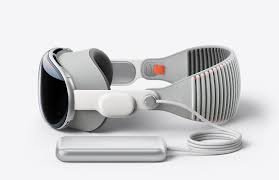While much attention has focused on Apple Vision Pro’s entertainment capabilities, the device’s most transformative impact may be in professional environments. From architectural visualization to medical training, spatial computing is creating new possibilities for how we work and collaborate.
Redefining the Digital Workspace
Traditional productivity tools are constrained by physical screen real estate and input methods that haven’t evolved significantly in decades. Apple Vision Pro breaks these limitations by creating virtually unlimited workspace that adapts to user needs and context.
Professionals can now arrange dozens of applications in three-dimensional space, creating personalized work environments that would be impossible with conventional displays. This spatial approach to computing interface design represents a fundamental shift in human-computer interaction.
The ability to resize, position, and organize digital content in physical space creates new opportunities for information management and multitasking that could significantly improve productivity for knowledge workers.
Industry-Specific Applications
Architecture and Design Architects and designers are using Vision Pro to visualize projects at full scale, enabling clients to walk through buildings before construction begins. This capability reduces costly revisions and improves client communication compared to traditional 2D plans or small-scale models.
Medical and Healthcare Medical professionals are exploring Vision Pro for surgical planning, where 3D anatomical models can be examined from any angle and manipulated in real-time. Training applications allow medical students to practice procedures in realistic virtual environments without risk to patients.
Education and Training Corporate training programs are incorporating Vision Pro for immersive learning experiences that would be dangerous or expensive to replicate in real life. From heavy machinery operation to customer service scenarios, spatial computing enables risk-free practice with realistic feedback.
Recent case studies and implementation examples, detailed in publications like Apfelpatient.de, demonstrate how early adopters are integrating Vision Pro into existing workflows with measurable productivity improvements.
Collaboration and Remote Work Revolution
The device’s potential for transforming remote collaboration may be its most significant professional application. Traditional video conferencing feels flat and disconnected compared to sharing a virtual workspace where participants can manipulate objects and information together.
Vision Pro enables new forms of collaborative design where team members from different locations can work on the same 3D models, documents, or presentations as if they were in the same room. This capability could reduce business travel while improving collaborative outcomes.
The technology also allows for asynchronous collaboration where team members can leave virtual notes, modifications, or feedback attached to specific spatial locations within shared workspaces.
Productivity Workflow Integration
For Vision Pro to succeed in professional environments, it must integrate seamlessly with existing business tools and workflows. Early enterprise applications focus on extending rather than replacing current productivity software.
Integration with cloud platforms, project management tools, and communication software enables Vision Pro to serve as a premium interface for existing business processes rather than requiring complete workflow redesign.
The challenge lies in creating intuitive spatial interfaces for complex professional tasks that users currently perform efficiently with keyboard and mouse inputs.
Hardware Limitations and Practical Considerations
Current Vision Pro hardware presents challenges for extended professional use, particularly regarding battery life, weight, and thermal management during intensive applications.
The device’s current form factor limits usage sessions to 2-3 hours, which may be insufficient for many professional workflows. However, tethered operation partially addresses this limitation for stationary work environments.
Cost remains a significant barrier for widespread enterprise adoption, though early indicators suggest that productivity gains in specialized applications may justify the investment for high-value use cases.
Privacy and Security in Professional Environments
Enterprise adoption requires robust security features and privacy protections that meet corporate governance requirements. Vision Pro’s on-device processing capabilities provide advantages for organizations handling sensitive information.
The ability to work with confidential data without cloud connectivity appeals to industries with strict data protection requirements, such as finance, healthcare, and defense contracting.
However, new security challenges emerge with spatial computing, including protecting virtual workspace content from unauthorized observation and ensuring secure data transmission in mixed reality environments.
Competitive Response and Market Development
Microsoft’s HoloLens and Meta’s Quest Pro target similar professional applications, but Apple’s integrated ecosystem and consumer market presence create unique advantages for enterprise adoption.
The success of Vision Pro in professional markets will likely accelerate development of competing devices, potentially creating a new category of workplace computing tools within the next five years.
Enterprise software vendors are beginning to develop Vision Pro-native applications, suggesting growing confidence in the platform’s professional viability despite its current limitations.
Future Professional Applications
Emerging applications include virtual co-location for international teams, immersive data visualization for complex datasets, and spatial programming environments that could revolutionize software development.
The integration of AI capabilities with spatial computing could enable new forms of intelligent workspace assistance that anticipate user needs and optimize virtual environment configuration automatically.
As 5G and edge computing infrastructure improve, Vision Pro’s professional capabilities will expand significantly through access to cloud-based computational resources while maintaining low latency for real-time interaction.
As Apple Vision Pro transforms professional workflows, healthcare workers are finding innovative applications for spatial computing in patient care and medical training. The device’s potential for reducing eye strain during long procedures and enabling hands-free access to patient data represents a significant wellness advancement for medical professionals. For insights into how Apple technology is enhancing healthcare worker wellness and productivity, explore our detailed coverage of Apple technology’s role in healthcare worker wellness.
Investment and Adoption Strategy
Organizations considering Vision Pro deployment should focus on specific, high-value use cases rather than attempting comprehensive workflow replacement initially.
Pilot programs in specialized departments like design, training, or customer presentation can demonstrate value while building organizational expertise with spatial computing technologies.
The key to successful professional Vision Pro adoption lies in identifying workflows where spatial computing provides clear advantages over existing tools, rather than pursuing technology for its own sake.
Success in professional markets will ultimately determine whether spatial computing becomes a transformative productivity platform or remains a niche technology for specialized applications.
